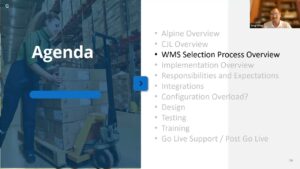In today’s fast-paced business environment, selecting the right enterprise software can make or break an organization’s success. From streamlining operations to enhancing customer experience, the right solution can drive significant value. However, navigating the software selection journey isn’t simply about finding the most popular solution and implementing it. It requires careful planning, thorough evaluation, and strategic decision-making. In a recent webinar, The Journey: Buying Enterprise Software Effectively, Alpine experts explored all the facets involved in navigating the software selection process. Read the main takeaways below, or watch a recording of the webinar here.
Getting started
Selecting enterprise software effectively is a multi-faceted journey that involves several key steps. It begins with defining clear objectives and requirements, followed by the creation of a Request for Proposal (RFP) to solicit vendor responses. Leadership involvement is crucial at every stage to ensure alignment with organizational goals and objectives. In our experience, project success depends on eight critical factors.
#1 Leadership: Strong leadership is provided by executive management to oversee the project and provide support to the team.
#2 Achieving buy-in: The team should comprise subject matter experts and involve representation from all aspects of the business (e.g. warehouse team, IT group, sales, executive leadership, etc.) to ensure you don’t miscalculate resources, gain buy-in and ensure all requirements are met.
#3 Focus on the goal: The team needs to be focused on the project’s success with no distracting ulterior motives.
#4 Be methodical: Engage in a deliberate, engaged, and thorough process.
#5 Anticipate change: Be prepared to adapt and pivot as needed, large undertakings rarely go off without some surprises.
#6 Invest in due diligence: Fully vet any solution, technology, vendor/integrator references. This involves evaluating not only the software but also the vendor’s operations, culture, technology, and integration capabilities.
- You may be wondering if hosting a traditional demonstration is enough to vet vendors, and we’re here to tell you, it’s not. A traditional vendor demonstration is performed in a vacuum, you’re seeing how their solution works on the best of days when everything is within control and going as planned. It may not show you how the solution works with regard to the specific functionality you are looking for. In some cases, what you want to learn is not necessarily if a vendor performs a certain function, but how they do it so you can determine if it fits in with your processes.
#7 Contracting: Get details on all contracting needs and their structure regarding software and services. It’s critical to discover if the vendor provides everything you need, and what contract limitations may be.
#8 Execution: Ensure you have a strategy in place to handle change management, scope, budget control, and any ongoing needs.
Most importantly, it’s critical to determine what your organization considers a measure of success for the project. All team members must be aligned on this to work toward the same goal.
Why Implementations fail
Unfortunately, around 80% of implementations fail, and it’s not always because of the solution, but rather due to organizational complications. Sometimes it’s because there’s no organizational commitment or the organization sets unrealistic expectations to begin with. Other reasons include:
- The system implementation is viewed as an IT project rather than an organizational one
- The selected vendor is a bad match
- Inadequate education and training of the implementation team and its users
- Inflexibility in adapting to new processes (trying to do things the same way as before with the new software)
- Inaccurate data loaded into the system
And while there are many ways buying enterprise software can go wrong, there are tried and true strategies that can help you navigate the selection process with confidence.
Best Practices
As the software selection journey progresses, there are several best practices and insights to keep in mind.
-
- A structured approach to the selection process is critical, with a focus on thoroughness and avoiding shortcuts. This includes getting a clear understanding of what the business requirements are. This is where real attention to detail is critical, and no item is too small to include.
- The RFP phase requires significant effort to ensure clarity and enable vendors to respond effectively. The list of business requirements will be the foundation of this RFP, and will enable organizations to vet solutions down to every last detail.
- Don’t limit your search to the well-known names. This is a significant investment, so you want to get a complete picture of all that’s available to you. Including up-and-coming vendors in the selection process can help keep established vendors competitive.
- During demonstrations, prioritize scenarios that align with the organization’s most critical needs and push vendors to showcase their capabilities beyond standard demos. If possible, have a list of worst-case scenarios specific to your operation that you can throw into the demo to see how the vendor would respond.
- Technical deep dives with vendors are essential for understanding their product roadmaps, especially regarding cloud-based solutions and ongoing development efforts.
- Don’t rush the selection process. Hosting periodic workshops with the team allows for detailed discussions on cost estimates, project plans, assumptions, and resource requirements. It will also ensure nothing has changed in the plan and that everybody is still working with the same end goal in mind.
- Create a point system that will allow for subjective scoring of each solution presented. Assessing subjective feedback alongside objective scoring helps make well-informed decisions and identify potential gaps in understanding.
Remember, the ROI break-even time frame for a WMS implementation varies based on factors like the organization’s goals, the current system, and the expected productivity gains. Be sure to calculate what the target time frame for your project is. Consider leveraging industry-accepted tools that help estimate the ROI and break-even time frame more accurately.
Conclusion
As you embark on your software selection journey, remember to keep your organizational goals at the forefront and leverage the insights shared in this blog post to guide your decision-making process. With the right approach and careful consideration, you can navigate the complexities of the software selection journey and unlock the full potential of your organization.
Researching, vetting, and sourcing enterprise software is not everybody’s expertise, that’s where we come in. If you’re looking to invest in enterprise software, but aren’t sure where to begin, we can help. We are experts in ensuring operations get the most out of their supply chain investments. Reach out. We’ll set you up with optimal solutions that drive maximum value.













